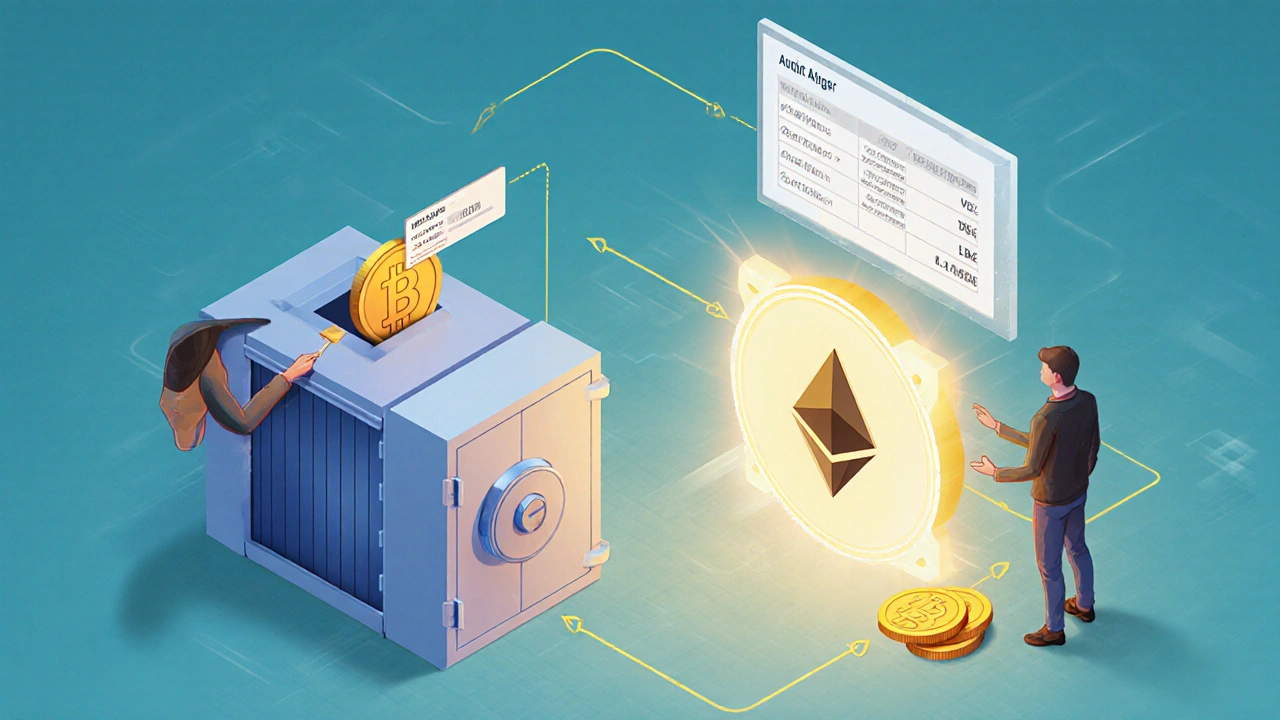Quick Summary
- Wrapped Bitcoin (wBTC) is an ERC‑20 token that represents Bitcoin on the Ethereum network.
- It is backed 1:1 by real BTC held by custodial partners.
- wBTC lets you use Bitcoin in DeFi apps, earn yield, and trade instantly.
- Risks include custodian trust, smart‑contract bugs, and bridge congestion.
- You can get wBTC via exchanges, decentralized bridges, or directly from custodians.
What Is Wrapped Bitcoin?
When you first hear wrapped bitcoin, think of a Bitcoin that lives on a different blockchain. In practice, wBTC is an ERC‑20 token that mirrors Bitcoin 1:1. Each wBTC token is backed by an actual BTC held in reserve by a network of custodians such as BitGo, Anchorage, and Fireblocks. The custodians lock the real BTC in cold storage, then issue the equivalent number of wBTC on Ethereum.
This tokenization enables Bitcoin holders to tap into Ethereum’s vibrant ecosystem without selling their BTC. The term "wrapped" simply means the original asset is encased in a smart‑contract wrapper that makes it compatible with another chain.
How Does wBTC Work on Ethereum?
Ethereum and Bitcoin use completely different consensus mechanisms and transaction formats. To bridge them, a set of smart contracts and trusted custodians act as translators. The process looks like this:
- A user sends BTC to a custodian’s deposit address.
- The custodian verifies receipt and updates a public audit ledger showing the total BTC held.
- Simultaneously, a smart contract that manages the minting and burning of wBTC mints an equal amount of wBTC and sends it to the user’s Ethereum address.
- If the user wants to convert back, they send the wBTC to the contract, which burns the tokens and instructs the custodian to release the corresponding BTC.
The crucial piece is the auditability of the reserves. Every custodian publishes daily proofs of reserve, and the wBTC contract includes functions that anyone can call to check the total supply against the BTC on‑chain.

Why Use wBTC?
There are three main reasons people wrap Bitcoin:
- DeFi Access: Ethereum hosts the largest collection of decentralized finance protocols-lending, borrowing, yield farming, and synthetic assets. wBTC lets you lock Bitcoin as collateral on platforms like Aave, Compound, or MakerDAO.
- Speed and Cost: Moving BTC on its native chain can take 10 minutes or more and cost $10‑$30 in fees. A transaction on Ethereum, especially after the London upgrade, can settle in seconds for a few dollars (or less on layer‑2 solutions).
- Liquidity Pools: Many decentralized exchanges (DEXs) such as Uniswap and SushiSwap list wBTC/ETH, wBTC/USDC, and other pairs. Providing liquidity with wBTC can earn you trading fees and additional token rewards.
In short, wBTC gives Bitcoin the flexibility of an ERC‑20 token while preserving its value.
Risks and Considerations
Even though wBTC opens doors, it also introduces new risks that you should weigh before jumping in:
- Custodian Trust: The 1:1 backing relies on custodians who hold the underlying BTC. If a custodian is hacked or goes insolvent, the bridge could lose value. Look for custodians with audited security practices and insurance coverage.
- Smart‑Contract Vulnerabilities: The wrapper contract is code that could contain bugs. While the wBTC contract has been audited multiple times, a future exploit could affect the mint/burn process.
- Bridge Congestion: During high network demand (e.g., a market crash), the Ethereum side can become congested, leading to higher gas fees and slower minting/burning.
- Regulatory Exposure: Some jurisdictions treat wrapped assets as securities or derivatives. Ensure you understand local regulations before using wBTC in large amounts.

How to Acquire and Use wBTC
Getting wBTC is straightforward, and you have three main pathways:
- Centralized Exchanges (CEX): Platforms like Coinbase, Binance, and Kraken list wBTC. Purchase BTC or USDC, then swap for wBTC on the exchange’s internal market.
- Decentralized Bridges: Services such as RenBridge, Orbiter, or the official wBTC Bridge let you lock BTC directly from a wallet (e.g., MetaMask) and receive wBTC instantly. You’ll pay both Bitcoin network fees and Ethereum gas.
- Custodian Direct Mint: If you have a large BTC balance, you can work with a custodian like BitGo to mint wBTC in bulk. This route is common for institutional players.
Once you hold wBTC in an Ethereum wallet, you can:
- Supply it as collateral on lending platforms.
- Swap it for other tokens on DEXs.
- Provide liquidity in a wBTC pool to earn fees.
- Use it in synthetic asset protocols to gain exposure to non‑crypto assets.
Comparison: wBTC vs Native Bitcoin vs Other Wrapped Tokens
| Attribute | Bitcoin (BTC) | Wrapped Bitcoin (wBTC) | renBTC (RenVM) |
|---|---|---|---|
| Chain | Bitcoin | Ethereum (ERC‑20) | Ethereum (ERC‑20) |
| Custody Model | Self‑custody or third‑party wallets | Custodial (BitGo, etc.) with audits | Decentralized network of nodes (no single custodian) |
| Liquidity Sources | Centralized exchanges, OTC desks | DEX pools, CEX markets, DeFi protocols | DEX pools, similar to wBTC |
| Use Cases | Store of value, direct payments | DeFi collateral, fast swaps, smart‑contract interactions | DeFi collateral, similar to wBTC but with decentralized minting |
| Risk Profile | Network security, private‑key loss | Custodian risk + smart‑contract risk | Validator‑node risk + smart‑contract risk |
Choosing between these depends on how much you value decentralization versus convenience. wBTC tends to be the most widely supported in DeFi, while renBTC offers a more trust‑less model at the cost of slightly lower liquidity.
Frequently Asked Questions
Is wBTC truly 1:1 backed by Bitcoin?
Yes. Every wBTC token is minted only after a custodian has locked an equal amount of BTC. Custodians publish daily proof‑of‑reserve audits that anyone can verify on the wBTC website.
Can I convert wBTC back to BTC instantly?
Conversion is fast but not instant. After you send wBTC to the burn contract, the custodian releases the BTC, which typically takes a few minutes depending on Bitcoin network congestion.
Do I need an Ethereum wallet to hold wBTC?
Yes. Since wBTC is an ERC‑20 token, you need a wallet that supports Ethereum addresses (e.g., MetaMask, Ledger, Trust Wallet). The wallet will store the token contract address and your balance.
Are there fees for minting or burning wBTC?
Yes. You pay the Bitcoin network fee to send BTC to the custodian, plus Ethereum gas to interact with the mint or burn contract. Some bridges also add a small service fee (usually 0.1‑0.5%).
Is wBTC safe for long‑term holding?
For most users, holding wBTC in a reputable hardware wallet or a secure DeFi platform is safe, provided you trust the custodians and keep the smart contract code audited. Diversifying between native BTC and wBTC can mitigate custodian risk.
